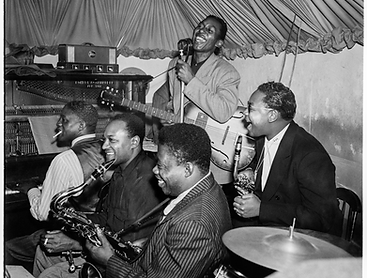

Basin Street
413 Maynard Avenue South
Down a steep staircase in the basement of the now demolished Olympus Hotel, which stood where Hing Hay Park is today, one of the district’s largest and most successful nightclubs once thrived. Named for a heralded New Orleans jazz venue, Basin Street opened its doors in 1939 after its owner, Dave Lee, a Black entrepreneur sometimes known affectionately as “Davey,” won a stake in the lottery that operated in a storefront across the street. (“You could watch,” recalled trumpeter Sonny Booker. “Bloom, bloom, bloom, these little dice would fall down. They’d be marking the numbers all in Chinese.”)
Popular with white college kids as well as people of color in the neighborhood, Basin Street featured jazz, booze and gambling 24 hours a day, starting at 6 a.m. with a breakfast show and ending with a late-late show at 3 a.m. In 1940, with business booming, Dave Lee opened the C.C. Billiards Parlor next door, at 415 S. Maynard St.
A large venue, Basin Street could accommodate about 200 patrons. At the height of its popularity, 20 waiters and five bartenders worked full-time. Floor shows with chorus girls and exotic dancing were a specialty, including a drag act in which one dancer flung another around by the hair. The club’s habitués included an eccentric fellow named Harold Curry, who came in nightly with a pet turtle on a leash, and another who routinely brought in a bucketful of silver dollars, which he tossed, willy-nilly, at the musicians. Every once in a while, out-of-town acts came in, including the Ink Spots, Count Basie, the International Sweethearts of Rhythm, Dexter Gordon, the great tap dancer Teddy Hale, and Sammy Davis Jr., who at that time worked with his uncle’s vaudeville group, the Will Mastin Trio.

The Leon Vaughn Band at Basin Street, 1948. Left to right: Ralph Stephens, Leon Vaughn, Aaron Davis, Clarence Williams (standing), Milton Walton. (Museum of History & Industry, Al Smith Collection, 2014.49.14.007.12)
The Olympus Hotel is the shorter dark building on the left, with faint lettering spelling its name on the side of the building, at the top left. The taller lighter-colored building on the right is the Bush Hotel, which is still standing. The entrance to Basin Street was through a door just left of the oval sign that identifies the Olympus Hotel. (Source: Washington State Archives, Puget Sound Regional Branch)
![Basin Street in Olympus Hotel hi res 524780-1950,_hotel,_1937[1] cropped.tif](https://static.wixstatic.com/media/b4878d_a7d76d96c96b4a8395726078831a7334~mv2.png/v1/crop/x_93,y_0,w_1314,h_984/fill/w_526,h_389,al_c,q_85,usm_0.66_1.00_0.01,enc_avif,quality_auto/Basin%20Street%20in%20Olympus%20Hotel%20hi%20res%20524780-1950%2C_hotel%2C_1937%5B1%5D%20cropped_tif.png)

Couple enjoying an evening at Basin Street, with a sign on the wall bearing the house slogan: “Stay with Your Party and Our Service Is Yours.” (Museum of History & Industry, Al Smith Collection, 2014.49.16.031.09)
Though it was an illegal after-hours club that paid off the police, Basin Street was a tightly run ship. As patrons descended the stairs, the first person they encountered was the bouncer, Gorilla Jones, an ex-middleweight champion and an old beau of Mae West, who still sent him a fresh white carnation every day. On the wall behind Jones hung a sign: “Stay with Your Party and Our Service Is Yours,” a rule urging customers to avoid quarrels by sticking to their own table.
Dave Lee had an understandable interest in keeping Basin Street cool and calm. An upstanding citizen, he was a member of the NAACP, the Black Elks and the prestigious Owl Club and was touted by Seattle’s Black newspaper, The Northwest Enterprise, as a “liberal contributor” to causes both sacred and secular. Tellingly, though The Northwest Enterprise regularly ran ads for the hotel and billiard parlor, the paper never referred openly to Basin Street itself, nor did the club advertise, which protected its secret gambling and alcohol enterprises. But coded messages appeared. One article referred to its owner as “Mr. Lee of the Basin”; another, written by Lee himself, carried the headline, “Stay With Your Party.”
In a twist of fate that highlights a dark intersection of two marginalized communities, Lee also benefited indirectly from the Japanese internment of 1942, which allowed him to acquire the Olympus Hotel, as well as the Atlas Café, across the street, when they were “left behind” by their Japanese American owners. By 1944 or 1945, however, with the war winding down and police raids becoming more than a nuisance, Lee sold Basin Street to Vernon Baker and another, unknown business partner, and opened a legitimate restaurant nearby. Baker brought in an up-and-coming teenage singer from Garfield High School, Ernestine Anderson, to play the breakfast show. Guitarist Al Mitchell also appeared at the club regularly after the war. But after a relentless series of raids, Basin Street appears to have ceased operations in 1948.

Hing Hay Park, with part of the Bush Hotel (now yellow) visible to the right. Basin Street was at 413 South Maynard Street, in the basement of the Olympus Hotel, where the park is today. Confusingly, the Basin Street’s 413 address was moved to the Bush Hotel after the demolition of the Olympus Hotel.
Next Stop: 9. The Tokiwa Hotel
As you stand in front of the entrance to Basin Street, gaze north toward South Jackson Street. On the side of a building that stands at the northeast corner of Maynard Avenue South and South Jackson Street, look for the faint white lettering that says “Rooms” and “Tokiwa Hotel.” To view this building from the front, walk north, cross South Jackson Street and look back at the building on the southeast corner.